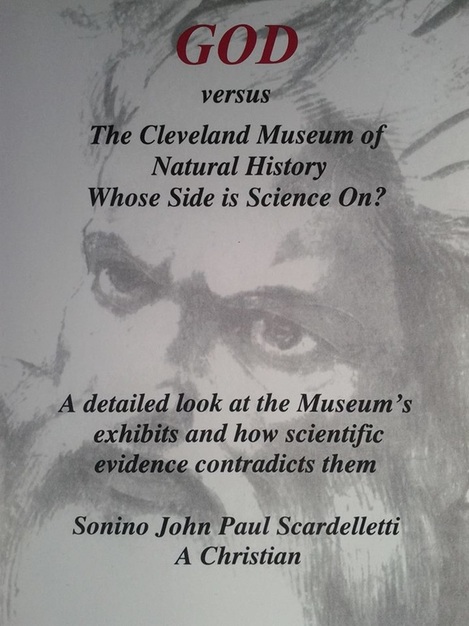God versus the Cleveland Museum of Natural History: Whose Side Is Science On? is a great example of such a book.
First, the bad news. Self-published in 2007, this slim volume cries out for an editor who knows how to handle citations and footnotes, how to break up long quotes, how to use bullets to speed the reader through even relatively technical material. These problems are extensive (and distracting) enough that I could not recommend the book without pointing them out.
But if you have an interest in the origins debate, and if you can look past such weaknesses, I can guarantee you of a fascinating and highly unorthodox exhibit-by-exhibit tour of “one of the finest natural history museums in North America,” as the web site of the Cleveland Museum of Natural History proclaims.
Here’s the main reason: In 178 information-packed pages, author Sonino John Paul Scardelletti presents overwhelming scientific refutations of what the Cleveland Museum presents as fact.
Through impressive secondary research of his own, Scardelletti rips apart supposed evolutionary evidences ranging from redshift to tree rings, from radiometric dating to dinosaur-to-bird fantasies.
He exposes the fatal errors in conventional interpretations of poor Lucy, whose now-famous skeleton says more about the fevered atheistic imaginations of evolutionists than it does about her family tree.
He quotes accomplices to the purveyors of evolutionary myths, including Ronald J. Ervin, an illustrator whose drawings of “human ancestors” were repeatedly revised, at the request of publishers, to support the transitional story line. “I just kept adding and subtracting until I got what they wanted,” an apparently contrite Ervin is quoted as saying on p. 143. (The Nebraska Man drawing shown above, published in 1922, is a telling example of such early wizardry; it was created by an artist from a single tooth, which ultimately was proven to have come from an extinct pig.)
He raises vital questions that cannot be addressed by evolutionary theory – for instance, "The body is lifeless (dead) without the life, but does the life live on without the body? For that matter, when a body dies, where does the life go?”
And so on. Although I’ve read considerably more on the subject than the average person, I found in this little book many arguments I’d not come across before – arguments made by respected scientists on both sides of the debate. That made reading it a cross-disciplinary adventure for me.
But what really set it apart for me is Scardelletti’s winsome style. I often felt like I was standing at the side of a Lieutenant Columbo or an Adrian Monk as he oh-so-sweetly and innocently went about torching the perpetrator’s alibis.
The proof of how much I enjoyed this book is in its margins. Amidst the corrections I wish he’d had an editor make before going to press are a steady flurry of comments such as “Excellent selection of quotes” and “Helps my understanding of the theory & its flaws” and “fine job of driving the point home!” and “love this sneak preview” and “great point!” I do tend to mark up my books, but usually not quite to this extent.
If you’re looking for the truth behind the exhibits at just about any natural history museum in the western world – or if you’d like to take a virtual tour with a disarmingly honest and charming guide – I give this book the thumbs up. Just expect to run into some editorial potholes along the way.
If you can't find God versus the Cleveland Museum of Natural History in bookstores, call the author at 216-531-6052, or contact him via Facebook.
Originally published 1/18/14

 RSS Feed
RSS Feed